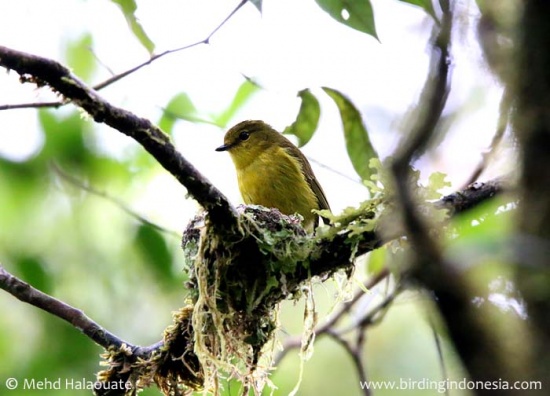m (→External Links: {{GS-checked}} <br /> <br />) |
(→External Links: GSearch expanded) |
||
| (One intermediate revision by the same user not shown) | |||
| Line 1: | Line 1: | ||
'''Alternative names: Canary Flycatcher; Montane Flycatcher; Papuan Flycatcher''' | '''Alternative names: Canary Flycatcher; Montane Flycatcher; Papuan Flycatcher''' | ||
[[Image:- Papuan Flycatcher.jpg|thumb|550px|right|Photo by {{user|mehdhalaouate|mehdhalaouate}}<br />Arfak Mountains, [[West Papua]], [[Indonesia]], November 2014]] | [[Image:- Papuan Flycatcher.jpg|thumb|550px|right|Photo by {{user|mehdhalaouate|mehdhalaouate}}<br />Arfak Mountains, [[West Papua]], [[Indonesia]], November 2014]] | ||
| − | ;[[:Category: | + | ;[[:Category:Devioeca|Devioeca]] papuana |
| + | ''Microeca papuana'' | ||
==Identification== | ==Identification== | ||
11·5–13 cm | 11·5–13 cm | ||
*Yellowish olive-green upperparts and face | *Yellowish olive-green upperparts and face | ||
*Olive-brown [[Topography#General Anatomy|remiges]] | *Olive-brown [[Topography#General Anatomy|remiges]] | ||
| − | |||
==Distribution== | ==Distribution== | ||
Southeast [[Asia]]: [[Indonesia]]<br /> | Southeast [[Asia]]: [[Indonesia]]<br /> | ||
| Line 12: | Line 12: | ||
==Taxonomy== | ==Taxonomy== | ||
This is a [[Dictionary_M-O#M|monotypic]] species<sup>[[#References|[1]]]</sup>. | This is a [[Dictionary_M-O#M|monotypic]] species<sup>[[#References|[1]]]</sup>. | ||
| − | |||
==Habitat== | ==Habitat== | ||
Montane forests, forest edges and clearings, at heights around 1800–2500 m, lower in some areas. | Montane forests, forest edges and clearings, at heights around 1800–2500 m, lower in some areas. | ||
| Line 21: | Line 20: | ||
In the Arfak mountains in the Vogelkop this species breed between September and October. During this period nests with one to 2 eggs and parents birds feeding chicks have been seen. | In the Arfak mountains in the Vogelkop this species breed between September and October. During this period nests with one to 2 eggs and parents birds feeding chicks have been seen. | ||
==References== | ==References== | ||
| − | #{{Ref- | + | #{{Ref-Clements6thOct23}}#Avibase |
#Handbook of the Birds of the World Alive (retrieved November 2014) | #Handbook of the Birds of the World Alive (retrieved November 2014) | ||
#BF Member observations | #BF Member observations | ||
{{ref}} | {{ref}} | ||
==External Links== | ==External Links== | ||
| − | {{GSearch|Microeca | + | {{GSearch|"Devioeca papuana" {{!}} "Microeca papuana" {{!}} "Canary Flyrobin" {{!}} "Canary Flycatcher" {{!}} "Montane Flycatcher" {{!}} "Papuan Flycatcher"}} |
| + | {{GS-checked}}1 | ||
| + | <br /> | ||
| + | <br /> | ||
[[Category:Birds]] [[Category:Microeca]] | [[Category:Birds]] [[Category:Microeca]] | ||
| − | |||
| − | |||
| − | |||
Latest revision as of 00:08, 12 November 2024
Alternative names: Canary Flycatcher; Montane Flycatcher; Papuan Flycatcher
- Devioeca papuana
Microeca papuana
Identification
11·5–13 cm
- Yellowish olive-green upperparts and face
- Olive-brown remiges
Distribution
Southeast Asia: Indonesia
Australasia: New Guinea, Melanesia.
Taxonomy
This is a monotypic species[1].
Habitat
Montane forests, forest edges and clearings, at heights around 1800–2500 m, lower in some areas.
Behaviour
Diet
Their diet consists almost entirely of insects, which includes beetles and weevils.
Breeding
In the Arfak mountains in the Vogelkop this species breed between September and October. During this period nests with one to 2 eggs and parents birds feeding chicks have been seen.
References
- Clements, J. F., P. C. Rasmussen, T. S. Schulenberg, M. J. Iliff, T. A. Fredericks, J. A. Gerbracht, D. Lepage, A. Spencer, S. M. Billerman, B. L. Sullivan, and C. L. Wood. 2023. The eBird/Clements checklist of Birds of the World: v2023. Downloaded from https://www.birds.cornell.edu/clementschecklist/download/
- Avibase
- Handbook of the Birds of the World Alive (retrieved November 2014)
- BF Member observations
Recommended Citation
- BirdForum Opus contributors. (2025) Canary Flyrobin. In: BirdForum, the forum for wild birds and birding. Retrieved 9 May 2025 from https://www.birdforum.net/opus/Canary_Flyrobin
External Links
GSearch checked for 2020 platform.1




